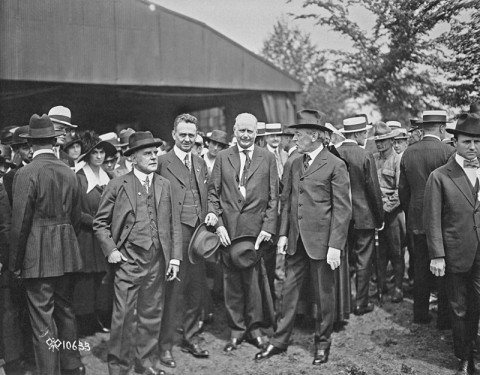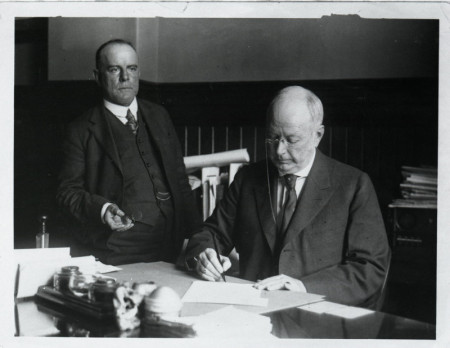
No federal agency in the administration of President Woodrow Wilson (right) was more dedicated to introducing new technologies than the Post Office Department, which developed the first civil uses for both trucks and airplanes. The architects of that work were Postmaster General Albert Sidney Burleson (center) and Second Assistant Postmaster General Otto Praeger (left), who headed all transportation activities for the post office. Washington, D.C., Postmaster Merritt Chance (second from left) joins them for the inauguration of airmail on May 15, 1918, from Potomac Park in Washington, D.C.
Otto Praeger spent two decades as a newspaper reporter, rising to Washington correspondent for the southwest’s most influential newspaper, The Dallas News, before being named postmaster of the nation’s capital by U.S. Postmaster General Albert Sidney Burleson, followed by appointment as second assistant postmaster general for the nation, with responsibility for all transportation, including horses, trucks, the railroad and airplanes.
Life-long Democrats and sons of Texas, Postmaster General Burleson (right)--who represented Austin during 14 years in the U.S. House of Representatives, and who was the grandson of General Edward Burleson, hero of the Texas Revolution who served as the first vice president of the Republic of Texas--and his second assistant, Otto Praeger, work in lock-step to bring progressive reform and technological advancement to the Post Office Department.
The airplane was considered little more than a weapon of war until they created the first commercial use for the airplane by establishing regularly scheduled air mail service.
Mavericks of the Sky draws on exhaustive research of new archival material to bring forward this unforgettable story of adventure, heroism and suspense set against the threshold of the Jazz Age. It was a dangerous time for mail pilots; fully one-quarter of the pilots died while trying to push the limits of flight to the extreme. Yet, still they signed on in droves—these ex-barnstormers, racecar drivers and WWI flying aces who willingly risked their lives in order to continue their obsession with flying.
Nicknamed “The Suicide Club,” the men of the U.S. Air Mail Service were an amalgam of brazen, headstrong aviators bent on defying the odds. Climbing into their flimsy wood and cloth-covered biplanes they moved the mail through torrential rain and blinding snowstorms, relying on their wits and instincts to keep them out of trouble.
They were constantly driven by tough-talking Second Assistant Postmaster General Otto Praeger—a gritty newspaperman who along with his boss Albert Burleson, the tenacious postmaster general in the cabinet of President Woodrow Wilson, held a common faith in the future of aviation.
Despite the deaths, the public skepticism and the contempt in which Congress held airmail, Praeger and Burleson refused to give up. Day after day, they held to the same impossible conviction—that airmail could be reliable and eventually far superior to rail service. To prove their point, mail pilots were ordered to maintain strict timetables through the cruelest of weather conditions, creating a bitter clash of wills between postal officials and the group-proud pilots who chafed under their vice-like dictums and policies.
Yet together, this battling group of visionaries left behind an undeniable legacy, both to modern aviation and to the world. Just three years after the first inaugural flight, the U.S. Post Office Department succeeded in expanding airmail westward, ultimately connecting the entire county by air, from New York to San Francisco, establishing the first reliable application of powered flight for civilian use.
Rosenberg and Macaulay unfold the lives and exploits of these unlikely American heroes in a narrative that is as irresistibly fascinating as its subject—revealing the underpinnings of the American pioneer spirit.
Hardcover published by William Morrow, paperback published by Harper Perennial, with Kindle version also available.



